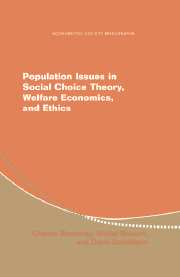Book contents
- Frontmatter
- 1 Introduction
- 2 Measurement of Individual Well-Being
- 3 Welfarist Social Evaluation
- 4 Fixed-Population Principles
- 5 Population Principles
- 6 Characterizations and Possibilities
- 7 Uncertainty and Incommensurabilities
- 8 Independence of the Existence of the Dead
- 9 Temporal Consistency
- 10 Choice Problems and Rationalizability
- 11 Applications
- References
- Author Index
- Subject Index
2 - Measurement of Individual Well-Being
Published online by Cambridge University Press: 05 January 2013
- Frontmatter
- 1 Introduction
- 2 Measurement of Individual Well-Being
- 3 Welfarist Social Evaluation
- 4 Fixed-Population Principles
- 5 Population Principles
- 6 Characterizations and Possibilities
- 7 Uncertainty and Incommensurabilities
- 8 Independence of the Existence of the Dead
- 9 Temporal Consistency
- 10 Choice Problems and Rationalizability
- 11 Applications
- References
- Author Index
- Subject Index
Summary
Part A
Consider a set of possible worlds, each of which is a history of the universe from remote past to distant future. At any particular time, the set of possible worlds is restricted to those whose past corresponds to the actual history of the universe. In this sense, history exhibits a branching structure. Individual or collective actions taken in the present determine the immediate branch along which history travels. Alternatives are labels or names for the worlds (histories), and principles for social evaluation rank them according to their goodness. For any two alternatives, one may be better than the other, the two may be equally good, or they may not be ranked at all, in which case we say they are incommensurable.
Welfarist principles rank alternatives on the basis of the well-being of the individuals that are alive in them without using other information. The approach we follow in this book is welfarist, and we provide a discussion in Chapter 3. Even in nonwelfarist approaches that employ other information, however, information about well-being also may be (and generally is) used to establish social rankings. Because it is of great importance to social evaluation in general, therefore, we devote this chapter to a discussion of individual well-being and its measurement.
- Type
- Chapter
- Information
- Publisher: Cambridge University PressPrint publication year: 2005



